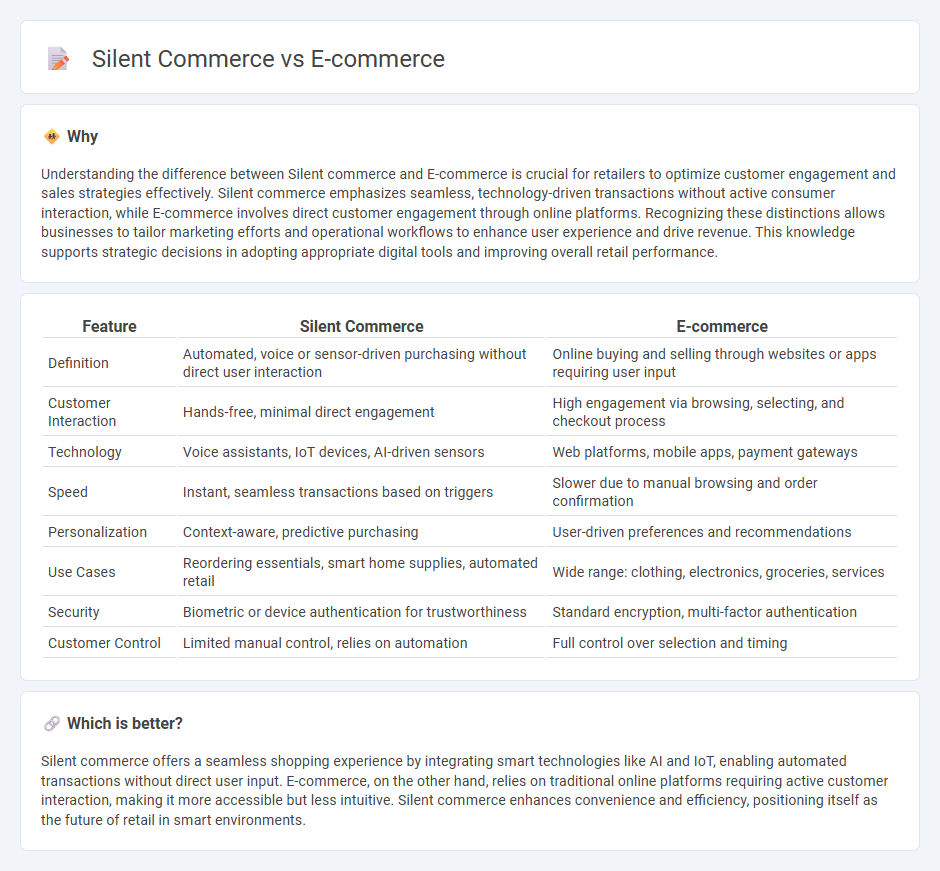
Silent commerce refers to automated retail transactions occurring without direct interaction between customers and sellers, often powered by IoT devices and AI technologies. E-commerce involves traditional online shopping platforms where consumers actively browse and purchase products via websites or apps. Explore the evolving dynamics between silent commerce and e-commerce to understand their impact on the retail landscape.
Why it is important
Understanding the difference between Silent commerce and E-commerce is crucial for retailers to optimize customer engagement and sales strategies effectively. Silent commerce emphasizes seamless, technology-driven transactions without active consumer interaction, while E-commerce involves direct customer engagement through online platforms. Recognizing these distinctions allows businesses to tailor marketing efforts and operational workflows to enhance user experience and drive revenue. This knowledge supports strategic decisions in adopting appropriate digital tools and improving overall retail performance.
Comparison Table
| Feature | Silent Commerce | E-commerce |
|---|---|---|
| Definition | Automated, voice or sensor-driven purchasing without direct user interaction | Online buying and selling through websites or apps requiring user input |
| Customer Interaction | Hands-free, minimal direct engagement | High engagement via browsing, selecting, and checkout process |
| Technology | Voice assistants, IoT devices, AI-driven sensors | Web platforms, mobile apps, payment gateways |
| Speed | Instant, seamless transactions based on triggers | Slower due to manual browsing and order confirmation |
| Personalization | Context-aware, predictive purchasing | User-driven preferences and recommendations |
| Use Cases | Reordering essentials, smart home supplies, automated retail | Wide range: clothing, electronics, groceries, services |
| Security | Biometric or device authentication for trustworthiness | Standard encryption, multi-factor authentication |
| Customer Control | Limited manual control, relies on automation | Full control over selection and timing |
Which is better?
Silent commerce offers a seamless shopping experience by integrating smart technologies like AI and IoT, enabling automated transactions without direct user input. E-commerce, on the other hand, relies on traditional online platforms requiring active customer interaction, making it more accessible but less intuitive. Silent commerce enhances convenience and efficiency, positioning itself as the future of retail in smart environments.
Connection
Silent commerce integrates seamlessly with e-commerce by enabling frictionless transactions through voice assistants, smart devices, and IoT technology, enhancing customer convenience and personalization. E-commerce platforms leverage silent commerce for automated inventory management, predictive analytics, and targeted marketing, driving efficiency and customer engagement. Together, they revolutionize retail by creating a seamless, data-driven shopping experience with minimal user intervention.
Key Terms
Digital Transactions
E-commerce involves online buying and selling through websites and apps, emphasizing visible digital transactions and customer interactions. Silent commerce, or invisible commerce, integrates seamless digital transactions within everyday activities using AI, IoT, and voice assistants, minimizing direct user engagement. Discover how these evolving digital transaction models reshape consumer experiences and business strategies.
Automated Purchasing
E-commerce leverages online platforms for manual purchasing processes, while silent commerce emphasizes fully automated transactions powered by AI and IoT technologies, streamlining consumer experiences without direct interaction. Silent commerce transforms traditional shopping by integrating smart devices and predictive analytics to anticipate customer needs, significantly reducing friction and wait times. Explore how automated purchasing is revolutionizing retail efficiency and customer engagement.
Touchless Experience
E-commerce traditionally involves online shopping through websites or apps, requiring user interaction such as clicks and searches to complete transactions. Silent commerce emphasizes a touchless experience by utilizing technologies like voice assistants, AI-driven recommendations, and automated payments to streamline purchasing without active user input. Explore the evolving landscape of silent commerce to understand how it revolutionizes convenience and customer engagement.
Source and External Links
What Is Ecommerce? Guide To Selling Online (2025) - Ecommerce is the buying and selling of goods and services over the internet, including online shopping, subscriptions, digital downloads, and more, and it mainly includes three types: direct to consumer (DTC), business to business (B2B), and consumer to consumer (C2C).
Glossary:E-commerce - Statistics Explained - Eurostat - E-commerce is generally defined as the sale or purchase of goods or services between businesses, households, individuals, or private organizations through electronic transactions over the internet or other online networks, including online orders, financial investments, reservations, and auctions.
Ecommerce (Learn About the Evolution of Online Shopping) - Ecommerce businesses operate on several main models, including business-to-consumer (B2C), business-to-business (B2B), and consumer-to-consumer (C2C), facilitating sales across a diverse range of products and services through websites, apps, and online marketplaces.
 dowidth.com
dowidth.com